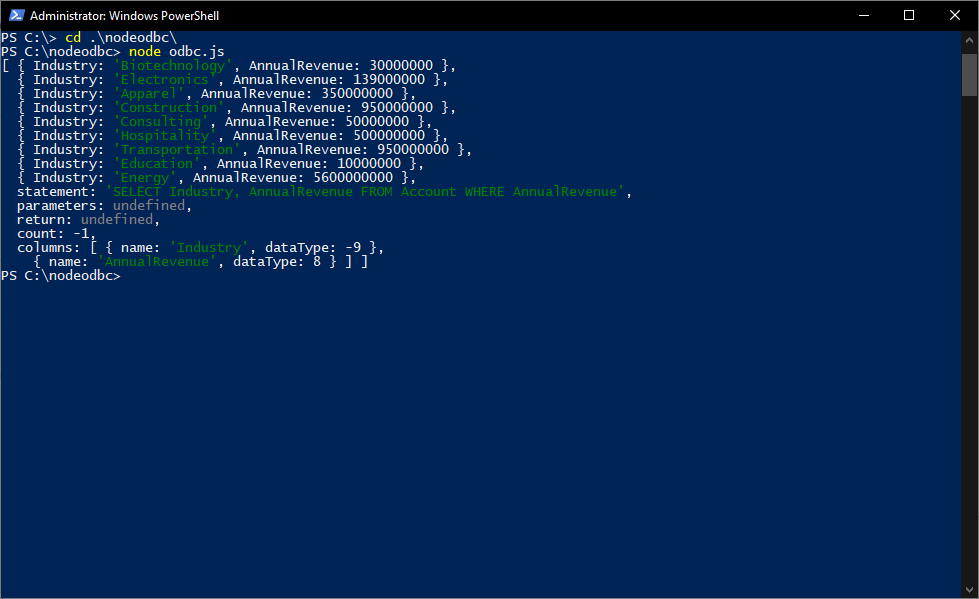Discover how a bimodal integration strategy can address the major data management challenges facing your organization today.
Get the Report →Query SAS Data Sets Data through ODBC in Node.js
Use node-odbc to execute SQL queries against SAS Data Sets data from Node.js.
Node.js is a JavaScript runtime environment that allows you to run JavaScript code outside of a browser. With the CData ODBC Driver for SAS Data Sets, you can access live SAS Data Sets data from Node.js apps and scripts. In this article, we walk through installing node-odbc and the required tools to create a simple Node.js app with access to live SAS Data Sets data.
With built-in optimized data processing, the CData ODBC Driver offers unmatched performance for interacting with live SAS Data Sets data in Node.js. When you issue complex SQL queries from Node.js to SAS Data Sets, the driver pushes supported SQL operations, like filters and aggregations, directly to SAS Data Sets and utilizes the embedded SQL engine to process unsupported operations client-side (often SQL functions and JOIN operations).
Connecting to SAS Data Sets Data
If you have not already done so, provide values for the required connection properties in the data source name (DSN). You can use the built-in Microsoft ODBC Data Source Administrator to configure the DSN. This is also the last step of the driver installation. See the "Getting Started" chapter in the help documentation for a guide to using the Microsoft ODBC Data Source Administrator to create and configure a DSN.
Set the following connection properties to connect to your SAS DataSet files:
Connecting to Local Files
- Set the Connection Type to "Local." Local files support SELECT, INSERT, and DELETE commands.
- Set the URI to a folder containing SAS files, e.g. C:\PATH\TO\FOLDER\.
Connecting to Cloud-Hosted SAS DataSet Files
While the driver is capable of pulling data from SAS DataSet files hosted on a variety of cloud data stores, INSERT, UPDATE, and DELETE are not supported outside of local files in this driver.
Set the Connection Type to the service hosting your SAS DataSet files. A unique prefix at the beginning of the URI connection property is used to identify the cloud data store and the remainder of the path is a relative path to the desired folder (one table per file) or single file (a single table). For more information, refer to the Getting Started section of the Help documentation.
Building node-odbc
In order to connect to SAS Data Sets through the CData ODBC Driver, you need to build node-odbc manually (after installing the required tools).
Installing the Required Tools
The following commands install the tools required to build node-odbc (note the -g parameter, which installs the tools globally).
npm i -g windows-build-tools npm i -g node-gyp
Building node-odbc
After installing the required tools, create a directory for the Node.js app and install odbc (which builds the binary for us to use in our Node.js script).
mkdir nodeodbc cd nodeodbc npm i -g node
Querying SAS Data Sets from Node.js
With the ODBC Driver installed, a DSN Configured, and node-odbc built, we are ready to query live SAS Data Sets data from a Node.js app. The sample code below connects to a specific DSN and queries the restaurants table.
myscript.js
const odbc = require('odbc');
async function querySASDataSets() {
const connection = await odbc.connect(`DSN=CData SASDataSets Source`);
const data = await connection.query('SELECT name, borough FROM restaurants');
console.log(data);
}
querySASDataSets();
Once you write the app, use node to execute the script:
node myscript.js

Download a free, 30-day trial of the CData ODBC Driver for SAS Data Sets and start working with your live SAS Data Sets data in Node.js. Reach out to our Support Team if you have any questions.






